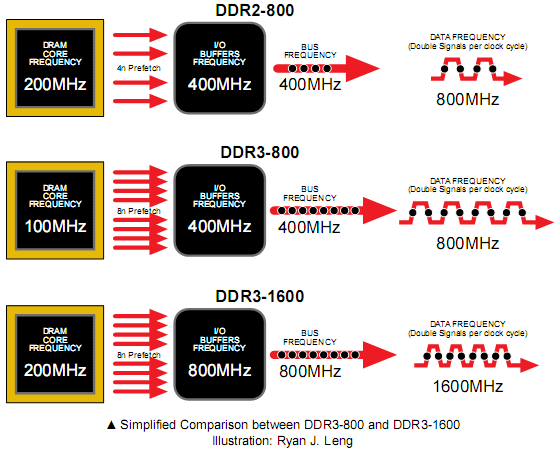
It is important for the average users to be aware that these super-high end modules have not been tested on wide range of motherboards for compatibility and it is extremely easy to announce memory products “capable” of these speeds even though very few motherboards can support it. These are simply aimed at generating marketing buzz and keeping the company brand in the news and people’s minds.
DDR3 modules are capable of reaching capacities of 16GB and possibly beyond. In contrast, DDR2 module capacity is expected to peak at 4GB per module, but these will be especially rare and fairly expensive relative to the 1GB and 2GB modules. DDR3 adoption is expected to pick up pace with the introduction of AMD’s AM3 processors and Intel’s next-generation Nehalem-based processors, where the whole processor market adopts an integrated memory controller with DDR3 support.
The voltage requirement is lowered with each generation of DDR, from DDR1’s 2.5V, DDR2’s 1.8V to 1.5V for DDR3, however the ultra fast DDR3 modules can require anywhere between 1.8-2.0V to function in a stable manner
Despite the default voltage at 1.5V, we expect to see some DDR3 modules with even lower power requirements; Brett Williams at Micron Technology informed us that there are Original Equipment Manufacturers (OEMs) pushing for fundamental changes in DDR3 memory controllers to allow for voltage options lower than 1.5V. Its mobile devices such as notebooks and ultra portable computers that are expected to use push for this feature to fulfil ever tighter power and thermal budgets.
One significant point is the expected adoption of Solid State Disks (SSD) in conjunction with ultra low voltage DDR3 for portable devices. The combined effect is astounding as they will significantly reduce the thermal envelope and the power consumption of the device, at the same time as increasing the potential performance. Thus, we can expect cooler-running laptops with batteries that last much longer.
Maintaining slower or the same core frequency as previous generations in design has positive influence on DRAM manufacturing yield and cost: it is about economics. High production yield contributes to cheaper DRAM, which in turn will influence consumer response and encourage a faster adoption rate.

Similar to DDR2, DDR3 supports programmable burst lengths of four and eight. However, conforming to the 8n-Prefetch rule, when using a burst length of four, back to back reads or writes will have gaps between bursts. For this reason, DDR3 introduces a burst chop command to allow on-the-fly selection of burst length.
DDR3 modules are capable of reaching capacities of 16GB and possibly beyond. In contrast, DDR2 module capacity is expected to peak at 4GB per module, but these will be especially rare and fairly expensive relative to the 1GB and 2GB modules. DDR3 adoption is expected to pick up pace with the introduction of AMD’s AM3 processors and Intel’s next-generation Nehalem-based processors, where the whole processor market adopts an integrated memory controller with DDR3 support.
DDR3 Power Reduction
The benefits of DDR3 include lower power consumption, faster and larger capacity and improved signal integrity management features.The voltage requirement is lowered with each generation of DDR, from DDR1’s 2.5V, DDR2’s 1.8V to 1.5V for DDR3, however the ultra fast DDR3 modules can require anywhere between 1.8-2.0V to function in a stable manner
Despite the default voltage at 1.5V, we expect to see some DDR3 modules with even lower power requirements; Brett Williams at Micron Technology informed us that there are Original Equipment Manufacturers (OEMs) pushing for fundamental changes in DDR3 memory controllers to allow for voltage options lower than 1.5V. Its mobile devices such as notebooks and ultra portable computers that are expected to use push for this feature to fulfil ever tighter power and thermal budgets.
One significant point is the expected adoption of Solid State Disks (SSD) in conjunction with ultra low voltage DDR3 for portable devices. The combined effect is astounding as they will significantly reduce the thermal envelope and the power consumption of the device, at the same time as increasing the potential performance. Thus, we can expect cooler-running laptops with batteries that last much longer.
Data Prefetch
DDR3 uses an “8n-prefetch”, where at each cycle the DRAM transmits 8-bits (1-Byte) of information from internal memory chip banks into IO buffers before sending them out. It is amazing to see the DRAM core frequency remaining pretty much the same since DDR1 while data throughput has increased by 800 percent! This is a testament to the ingenuity of the engineering community.Maintaining slower or the same core frequency as previous generations in design has positive influence on DRAM manufacturing yield and cost: it is about economics. High production yield contributes to cheaper DRAM, which in turn will influence consumer response and encourage a faster adoption rate.

Similar to DDR2, DDR3 supports programmable burst lengths of four and eight. However, conforming to the 8n-Prefetch rule, when using a burst length of four, back to back reads or writes will have gaps between bursts. For this reason, DDR3 introduces a burst chop command to allow on-the-fly selection of burst length.

MSI MPG Velox 100R Chassis Review
October 14 2021 | 15:04








Want to comment? Please log in.